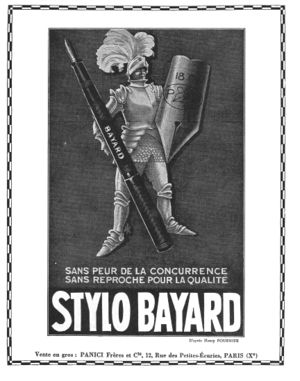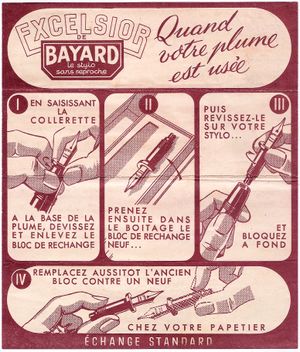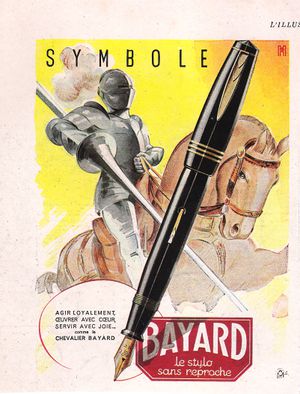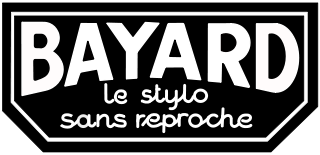Differenze tra le versioni di "Bayard/en"
(Aggiornamento come da nuova versione della pagina di origine) |
|||
| (48 versioni intermedie di 2 utenti non mostrate) | |||
| Riga 9: | Riga 9: | ||
[[Image:1923-Bayard.jpg|thumb|A 1923 [[Bayard]] ADs]] | [[Image:1923-Bayard.jpg|thumb|A 1923 [[Bayard]] ADs]] | ||
| − | The company officially took the name [[Bayard]] only in [[ | + | The company officially took the name [[Bayard]] only in [[1932]], when the ''Panic Frères & Co.'' was renamed in ''Stylo Bayard''. The company had its origins in the late years of 1800, starting from the activities of a Parisian bookseller, ''Etienne Forbin'', who in [[1903]] took the reselling rights of various American writing instruments producers. In [[1912]] he registered the trademark [[Bayard]]. In [[1922]] the Forbin grandchildrens resumed the work of their grandfather founding the ''Société Panic Frères'' and started a fountain pens production. But for marketing reasons, they used as trademark the name of the medieval knight [http://fr.wikipedia.org/wiki/Pierre_Terrail_de_Bayard Pierre Terrail de Bayard], that was an hero of the wars in the medieval Italy, considered as the image of the knight without fear and without blemish. |
The initial models were the classic pens in [[BCHR|chased]] or [[mottled]] hard rubber, made in cylindrical shapes with the classical [[eyedropper filler|eyedropper]] or [[safety]] filling system. There were also luxury models with gold or silver [[overlay]]s. The pens were advertised using the figure of a knight who had a nib as a shield and a pen as a spear; the advertising claimed that the [[Bayard]] pens did not feared competition or remarks on their quality. The nibs of these first models were marked with the symbol PF (standing for ''Panici Frères'') except for the top models that had the nib marked with the word ''"Bayard"'', which otherwise was normally reported on the pen body. | The initial models were the classic pens in [[BCHR|chased]] or [[mottled]] hard rubber, made in cylindrical shapes with the classical [[eyedropper filler|eyedropper]] or [[safety]] filling system. There were also luxury models with gold or silver [[overlay]]s. The pens were advertised using the figure of a knight who had a nib as a shield and a pen as a spear; the advertising claimed that the [[Bayard]] pens did not feared competition or remarks on their quality. The nibs of these first models were marked with the symbol PF (standing for ''Panici Frères'') except for the top models that had the nib marked with the word ''"Bayard"'', which otherwise was normally reported on the pen body. | ||
| Riga 15: | Riga 15: | ||
In [[1927]] were first introduced [[lever filler]] models, that in [[1930]] were divided into two series, the ''Normal'' and the ''De Luxe''. In the late '20s the company began to produce their firsts celluloid models, and launched the [[Bayard 446|446]] series, in jade, ruby and lapislazuli, with a special removable back that could be replaced to use the pen on a pen-holders table. | In [[1927]] were first introduced [[lever filler]] models, that in [[1930]] were divided into two series, the ''Normal'' and the ''De Luxe''. In the late '20s the company began to produce their firsts celluloid models, and launched the [[Bayard 446|446]] series, in jade, ruby and lapislazuli, with a special removable back that could be replaced to use the pen on a pen-holders table. | ||
| − | In [[1932]] production was reorganized, and | + | In [[1932]] production was reorganized, the company changed location and name<ref>the change can be seen from the difference between [[:File:1931-11-Bayard-Superluxe.jpg|this advertisement]] of November 1931 compared to [[:File:1932-10-Bayard-Special-8.jpg|this one]] of October 1932.</ref> from ''"MM. Panici Frères"'' in rue de Petits-Ecuries 12 to ''"Stylo Bayard"'' in rue des Cordelières 31. At the end of 1931 the [[Superluxe]] top model had been introduced, a [[lever filler]] with gold nib, produced in coloured material (not flammable, therefore probably galalith), in the colours black, iridescent marbled gold and iridescent marbled green. The new pens had [[streamlined]] forms, with the ends of cap and body of conical shape, and were produced both men and woman models. |
| − | + | In 1932 a cheap model was launched, the [[Special 8]]; it was a [[lever filler]] (but also a [[safety]] was available), in black or marbled [[hard rubber]] with an metal alloy nib (but it appears also with gold nib), still in [[flat-top]] style but with an octagonal cap head. Then was introduced also the series [[Bayard Luxe|Luxe]], a mid-range pen compared to the [[Superluxe]], also a [[lever filler]], with gold nib, and produced in different colours and slightly tapered shapes, with truncated cone ends for cap and body in the style of the [[Superluxe]], but with simpler finishing. | |
| − | + | The next year another models reorganization was made, the [[Special 8]] and [[Bayard Luxe|Luxe]] were provided with a sword-shaped clip inserted laterally in the cap; as a consequence of this on the economy line [[Special 8]] the octagonal cap head was removed, and it became an ordinary [[flat-top]]. Finally the '''[[Superluxe|Superluxe Grosse Containance]]'' was introduced, a model of larger size and ink capacity, decorated with a [[Patrician]] style band on the cap instead of the two rings. | |
| − | < | + | Around [[1935]]<ref>the date is reported in [https://web.archive.org/web/20131217133442/http://bayard.penandco.com/accueil_us.html here] but the oldest available advertisement showing these variations is [[:File:1936-12-Bayard-Models.jpg|this one]] of 1936.</ref> |
| − | [[ | + | also the pair of rings of the ordinary [[Superluxe]] were replaced by a new band decorated with a different pattern, adopted by the whole series; at the same time the clip was also modified assuming a tie/spear shape and losing the ''Bayard'' imprint. In [[1937]] the [[Bayard Luxe|Luxe]] series was replaced by the [[Special Luxe]], made of marbled celluloid in marbled colours, and also equipped with a decorated band on the cap. At the end of [[1938]],<ref>date is uncertain, [https://web.archive.org/web/20130601100021/http://paperandco.com/blog/2011/10/stylo-plume-bayard-sans-peur-et-sans-reproche this page] reports 1939, but the name is citen in some December 1938 advertising, so we assume this year.</ref> following the trend introduced by the [[Vacumatic]], [[Bayard]] introduced a new model equipped with transparent barrel to stem the ink level vision, called [[Niveauclair]]. |
| − | </ | ||
| − | + | [[File:194x-Bayard-Excelsior-Instro-Back.jpg|thumb|Instruction for the [[Excelsior de Bayard|Excelsior]] model]] | |
| − | In [[1940]] there was a restyling of the [[ | + | In that same period<ref>the two trademarks and the new model appear in [[:File:1939-08-Bayard-Pricelist-Int.jpg|this price list]] of August 1939 </ref> the [[Le 4 de Bayard]], a new economic line cheaper than the [[Special 8]], was introduced and also two other flagship sub-brands were used directed towards two different market segments: the ''[[Excelsior]]'' brand for the second tier of medium quality pen production, and the ''[[Alpin]]'' brand used for cheaper pens produced for the lower end of the market, mainly students and schoolchildren. |
| + | |||
| + | In [[1940]] there was a restyling of the [[Superluxe]] line going towards a more streamlined cap but maintaining the conical ends of the pen and the new [[Superstyl]] was introduced, still a [[lever filler]], in two versions, for men and women. The [[Superstyl]] had three rings on the cap and a spear-shaped clip with a double "V" pattern; it was made of celluloid produced in many colors, and equipped with a gold nib. | ||
[[Image:1944-Bayard.jpg|thumb|left|A 1944 [[Bayard]] ADs]] | [[Image:1944-Bayard.jpg|thumb|left|A 1944 [[Bayard]] ADs]] | ||
| − | The Second World War period was critical, as the use of gold was forbidden in many European country, and the celluloid supply began to run low. The company still tried to maintain high quality, while using steel nibs. Around [[1943]] was introduced the [[Excelsior]] model; it was very similar to the [[Superstyl]], but with a steel nib branded with the ''Excelsior'' name. The innovative feature of this pen was that the whole nib block was interchangeable, since the steel nibs were subject to greater wear, and the pen was sold with a spare The model was successful, and despite the restrictions had disappeared after the war, it remained in production until [[1948]]. | + | The Second World War period was critical, as the use of gold was forbidden in many European country, and the [[celluloid]] supply began to run low. The company still tried to maintain high quality, while using steel nibs. Around [[1943]] was introduced the [[Excelsior]] model; it was very similar to the [[Superstyl]], but with a steel nib branded with the ''Excelsior'' name. The innovative feature of this pen was that the whole nib block was interchangeable, since the steel nibs were subject to greater wear, and the pen was sold with a spare The model was successful, and despite the restrictions had disappeared after the war, it remained in production until [[1948]]. |
| − | + | Around [[1946]] the different model lines, the [[Le 4 de Bayard|Le 4]], the [[Special 8]], the [[Special Luxe]] and the [[Superstyl]] underwent a restyling following the overseas trends, the latter two with completely ogival lines and new shapes for the clip. In [[1949]] a further variant of the [[Superstyl]] model was also introduced, with a metal cap. In the same year the company launched some other models: the [[Super Bayard]] as a new top model, the [[Capostyl]] with ''[[hooded nib]]''. All of them were [[button filler]]. | |
| − | In the early 50's the stylistic lines were uniformed and the various series took a similar form. All models moved to a fully streamlined shape losing the tapered conical ends. In | + | In the early 50's the stylistic lines were uniformed and the various series took a similar form. All models moved to a fully streamlined shape losing the tapered conical ends. In this same period other models were launched as the [[Bayard 2000]] and a new version of the [[Niveauclair]], with this one other [[pump filler]] models were produced like the ''Excelsior 507'', and also some [[accordion filler]] model (the [[Stylomine]] patent was expired) like the [[Fit]]. |
| − | During the '50s the company | + | During the '50s the company the company suffered a continuous decline in sales caused by the growing market share of the ballpoint pen. It sought the relaunch in in [[1956]] with the [[Souverain]] model, a streamlined [[hooded nib]] pen with [[accordion filler]], produced also later with a metal cap as [[Souverain de Luxe]]. But at the time the writing instruments market was dominated by ballpoint pens; smaller models were introduced, such as the [[Dauphin]], the [[Bayard 20]], the [[Bayard 30]] and the [[Karting]], a [[cartridge filler]] pen, but the decline continued inexorably until the final closure November 5, 1973.<ref>according to [https://web.archive.org/web/20130601100021/http://paperandco.com/blog/2011/10/stylo-plume-bayard-sans-peur-et-sans-reproche this page].</ref> |
{{BrandChrono|Bayard}} | {{BrandChrono|Bayard}} | ||
| Riga 45: | Riga 46: | ||
* [http://web.archive.org/web/20071012005121/www.stylos-francais.fr/bayard.php] Brand page on a decommissioned website on French fountain pens. | * [http://web.archive.org/web/20071012005121/www.stylos-francais.fr/bayard.php] Brand page on a decommissioned website on French fountain pens. | ||
* [https://web.archive.org/web/20130601100021/http://paperandco.com/blog/2011/10/stylo-plume-bayard-sans-peur-et-sans-reproche] Brand page on a decommissioned website. | * [https://web.archive.org/web/20130601100021/http://paperandco.com/blog/2011/10/stylo-plume-bayard-sans-peur-et-sans-reproche] Brand page on a decommissioned website. | ||
| + | * [http://www.fountainpennetwork.com/forum/topic/273730-some-bayard-pens/] Discussion on FPN with some historical notes and where various models are shown. | ||
==Notes== | ==Notes== | ||
<references/> | <references/> | ||
{{CategorizeBrand|Francia}} | {{CategorizeBrand|Francia}} | ||
Versione delle 21:21, 26 apr 2020
Bayard is a major historic French fountain pen brand; the company was founded in 1922 and has continued operations until the '60s when, as most historical producers, was taken down by the revolution of the ballpoint pen.
Bayard fountain pens were characterized by good overall quality, certainly in par with the one of the American producers, even though the company was never reported for specific innovative technical contributions, the validity of its products has ensured the success and is still valued by collectors.
| Bayard |
|---|
| Brand pages |
| Brand advertising |
| Brand photos |
| Instructions sheet |
| Other documents |
| Patents |
History

The company officially took the name Bayard only in 1932, when the Panic Frères & Co. was renamed in Stylo Bayard. The company had its origins in the late years of 1800, starting from the activities of a Parisian bookseller, Etienne Forbin, who in 1903 took the reselling rights of various American writing instruments producers. In 1912 he registered the trademark Bayard. In 1922 the Forbin grandchildrens resumed the work of their grandfather founding the Société Panic Frères and started a fountain pens production. But for marketing reasons, they used as trademark the name of the medieval knight Pierre Terrail de Bayard, that was an hero of the wars in the medieval Italy, considered as the image of the knight without fear and without blemish.
The initial models were the classic pens in chased or mottled hard rubber, made in cylindrical shapes with the classical eyedropper or safety filling system. There were also luxury models with gold or silver overlays. The pens were advertised using the figure of a knight who had a nib as a shield and a pen as a spear; the advertising claimed that the Bayard pens did not feared competition or remarks on their quality. The nibs of these first models were marked with the symbol PF (standing for Panici Frères) except for the top models that had the nib marked with the word "Bayard", which otherwise was normally reported on the pen body.
In 1927 were first introduced lever filler models, that in 1930 were divided into two series, the Normal and the De Luxe. In the late '20s the company began to produce their firsts celluloid models, and launched the 446 series, in jade, ruby and lapislazuli, with a special removable back that could be replaced to use the pen on a pen-holders table.
In 1932 production was reorganized, the company changed location and name[1] from "MM. Panici Frères" in rue de Petits-Ecuries 12 to "Stylo Bayard" in rue des Cordelières 31. At the end of 1931 the Superluxe top model had been introduced, a lever filler with gold nib, produced in coloured material (not flammable, therefore probably galalith), in the colours black, iridescent marbled gold and iridescent marbled green. The new pens had streamlined forms, with the ends of cap and body of conical shape, and were produced both men and woman models.
In 1932 a cheap model was launched, the Special 8; it was a lever filler (but also a safety was available), in black or marbled hard rubber with an metal alloy nib (but it appears also with gold nib), still in flat-top style but with an octagonal cap head. Then was introduced also the series Luxe, a mid-range pen compared to the Superluxe, also a lever filler, with gold nib, and produced in different colours and slightly tapered shapes, with truncated cone ends for cap and body in the style of the Superluxe, but with simpler finishing.
The next year another models reorganization was made, the Special 8 and Luxe were provided with a sword-shaped clip inserted laterally in the cap; as a consequence of this on the economy line Special 8 the octagonal cap head was removed, and it became an ordinary flat-top. Finally the 'Superluxe Grosse Containance was introduced, a model of larger size and ink capacity, decorated with a Patrician style band on the cap instead of the two rings.
Around 1935[2] also the pair of rings of the ordinary Superluxe were replaced by a new band decorated with a different pattern, adopted by the whole series; at the same time the clip was also modified assuming a tie/spear shape and losing the Bayard imprint. In 1937 the Luxe series was replaced by the Special Luxe, made of marbled celluloid in marbled colours, and also equipped with a decorated band on the cap. At the end of 1938,[3] following the trend introduced by the Vacumatic, Bayard introduced a new model equipped with transparent barrel to stem the ink level vision, called Niveauclair.

In that same period[4] the Le 4 de Bayard, a new economic line cheaper than the Special 8, was introduced and also two other flagship sub-brands were used directed towards two different market segments: the Excelsior brand for the second tier of medium quality pen production, and the Alpin brand used for cheaper pens produced for the lower end of the market, mainly students and schoolchildren.
In 1940 there was a restyling of the Superluxe line going towards a more streamlined cap but maintaining the conical ends of the pen and the new Superstyl was introduced, still a lever filler, in two versions, for men and women. The Superstyl had three rings on the cap and a spear-shaped clip with a double "V" pattern; it was made of celluloid produced in many colors, and equipped with a gold nib.

The Second World War period was critical, as the use of gold was forbidden in many European country, and the celluloid supply began to run low. The company still tried to maintain high quality, while using steel nibs. Around 1943 was introduced the Excelsior model; it was very similar to the Superstyl, but with a steel nib branded with the Excelsior name. The innovative feature of this pen was that the whole nib block was interchangeable, since the steel nibs were subject to greater wear, and the pen was sold with a spare The model was successful, and despite the restrictions had disappeared after the war, it remained in production until 1948.
Around 1946 the different model lines, the Le 4, the Special 8, the Special Luxe and the Superstyl underwent a restyling following the overseas trends, the latter two with completely ogival lines and new shapes for the clip. In 1949 a further variant of the Superstyl model was also introduced, with a metal cap. In the same year the company launched some other models: the Super Bayard as a new top model, the Capostyl with hooded nib. All of them were button filler.
In the early 50's the stylistic lines were uniformed and the various series took a similar form. All models moved to a fully streamlined shape losing the tapered conical ends. In this same period other models were launched as the Bayard 2000 and a new version of the Niveauclair, with this one other pump filler models were produced like the Excelsior 507, and also some accordion filler model (the Stylomine patent was expired) like the Fit.
During the '50s the company the company suffered a continuous decline in sales caused by the growing market share of the ballpoint pen. It sought the relaunch in in 1956 with the Souverain model, a streamlined hooded nib pen with accordion filler, produced also later with a metal cap as Souverain de Luxe. But at the time the writing instruments market was dominated by ballpoint pens; smaller models were introduced, such as the Dauphin, the Bayard 20, the Bayard 30 and the Karting, a cartridge filler pen, but the decline continued inexorably until the final closure November 5, 1973.[5]
Chronology
| Year | Event |
|---|---|
| 1903 | Etienne Forbin become agent for some U.S. writing instruments manufacturers, is the origin of the company |
| 1912 | Etienne Forbin registers Bayard trademark |
| 1922 | the company Panici Freres & Co is founded, they will produce the Bayard pens |
| 1927 | the company introduces its first lever filler models |
| 1929 | the company introduces its first celluloid models |
| 1929 | the company introduces the Bayard 446 |
| 1930 | the company introduces the Normal |
| 1930 | the company introduces the De Luxe |
| 1931 | the company introduces the Superluxe |
| 1932 | the company introduces the Bayard Luxe |
| 1932 | the company introduces the Special 8 |
| 1932 | Panici Freres & Co is renamed Stylo Bayard and the trademark "Bayard" is engraved on clips |
| 1933 | the company introduces the Superluxe Grosse Containance |
| 1935 | the company introduces a decorated band on Superluxe model |
| 1937 | the company introduces the Special Luxe |
| 1937 | the company retires the Bayard Luxe |
| 1938 | the company introduces the Niveauclair with visible ink level |
| 1938 | the company introduces another band in the Special Luxe |
| 1938 | the company introduces the Le 4 de Bayard (upper limit from this advertisement) |
| 1940 | the company retires the Superluxe |
| 1940 | the company introduces the Superstyl |
| 1942 | the company introduces the Excelsior with changeable nib |
| 1947 | the company introduces a Le 4 de Bayard new version |
| 1947 | the company introduces a Special 8 new version |
| 1947 | the company introduces a Special Luxe new version |
| 1948 | the company retires the Excelsior |
| 1949 | the company introduces the Capostyl |
| 1949 | the company introduces the Super Bayard |
| 1949 | the company introduces the Superstyl in a new version |
| 1949 | the company introduces the Special 8 economic version |
| 1956 | the company introduces the Souverain |
| 1958 | the company introduces the accordion filler for the Souverain de Luxe |
| 1973 | the company ceases operations |
External references
- [1] Page of the brand owners, with many historical information.
- [2] Brand page on a decommissioned website on French fountain pens.
- [3] Brand page on a decommissioned website.
- [4] Discussion on FPN with some historical notes and where various models are shown.
Notes
- ↑ the change can be seen from the difference between this advertisement of November 1931 compared to this one of October 1932.
- ↑ the date is reported in here but the oldest available advertisement showing these variations is this one of 1936.
- ↑ date is uncertain, this page reports 1939, but the name is citen in some December 1938 advertising, so we assume this year.
- ↑ the two trademarks and the new model appear in this price list of August 1939
- ↑ according to this page.
